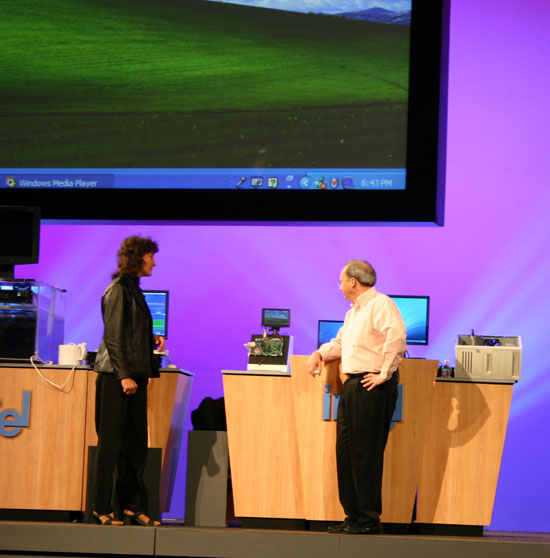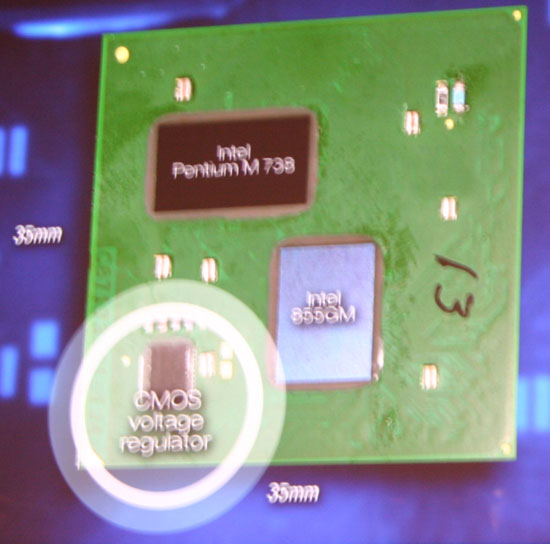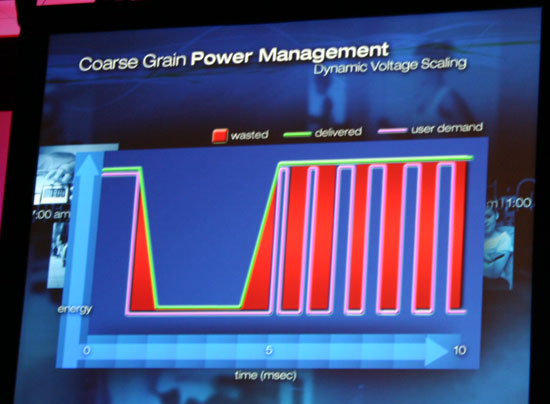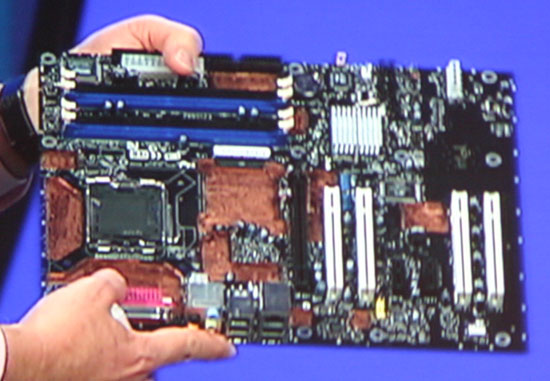Fall IDF 2005 - Day 3: Intel Demos On-Chip North Bridge & Voltage Regulator
by Anand Lal Shimpi on August 25, 2005 12:39 PM EST- Posted in
- Trade Shows
One of the biggest performance and technology advantages AMD has hold over Intel has been their on-die memory controller and North Bridge. Not only does AMD's on-die memory controller increase performance, but it saves overall system power as it can take advantage of the CPU's power management and advancements in microprocessor manufacturing technology.

Intel went in a slightly different direction today and showcased a research project of a Pentium M processor with an on-package GMCH, or North Bridge with integrated graphics.

Obviously this is different from doing an on-die north bridge, but you do get some significant performance benefits from moving the GMCH on chip. Note that the graphics core is also on the package, which is something we've heard AMD may be working on, but we were actually able to see a working demo from Intel today.

The integration went one step further, and included an on-package CMOS voltage regulator. The idea behind this integration step is that conventional voltage regulators on motherboards are relatively slow, they can't switch between voltage levels too quickly. They especially can't switch at the same rate as CPU demand changes:

Current Technology, the green line represents voltage and the blue spikes represent CPU demand
By moving to an on-package CMOS voltage regulator you not only simplify the motherboard, but you also get much faster voltage switching, meaning the voltage regulator can actually switch more frequently with CPU demand - resulting in something like the graph below.

CMOS based voltage regulators will enable much finer grained switching
Intel didn't commit to a timeframe of introducing this technology, but given that they had working silicon, we can expect that this project is something they truly wish to pursue.

A prototype motherboard using the technology. Note the lack of voltage regulators on the motherboard and the missing GMCH (North Bridge) chip.










36 Comments
View All Comments
Doormat - Thursday, August 25, 2005 - link
IIRC, the original design for what became the Pentium M was known as the "Timna". It was designed to integrate the northbridge onto the CPU (including a Rambus memory controller). The project was canned, and the project got rolled over into Banias. Now here we are in 2005 and we are almost back to where we started. The northbridge in the same packaging as the CPU. The next logical step is to, of course, put the entire NB into the same die as the CPU - which might be quite possible by 45nm.bupkus - Thursday, August 25, 2005 - link
First abandoning low-end chipsets and now simplifying motherboard design. What do these two events tell you if anything?Will this reap power consumption benefits for laptops? Cheaper, smaller, cooler desktop designs for the office? Also, see "Latest News" on "Vista's answer to PC power woes."
gimpsoft - Thursday, August 25, 2005 - link
wonder if lower motherboard's complexity.lower motherboard prices just like AMD boards
http://www.dslreports.com/shownews/66802">http://www.dslreports.com/shownews/66802
anyone see the article intel is going after sony and M$ for control of living room
hahaha funny how by moding and XBOX you can have a $150 media center PC and by Novenber $99
just intel chips alone cost that much not including motherboard HD case next gen PS3 and xbox 360 can play back HD no problem for $300 + mod chip if you want extra functions
let not forget DRM
8NP4iN - Thursday, August 25, 2005 - link
wassup with intel, suddently they are coming with all thins great stufflook at the buzz theyr generating... AMD better have something under theyr sleeves or theyll go back to losing money business again...they had theyr chance, 3 years being the top performer and only managed to take the a bit of the server market, but still in desktop market people dont know how much theyr superior to P4... its amazing how manny people still are in the mhz thing and people who think ExtremeEdition is the shit... im sad lol, we are so few!
PrinceGaz - Tuesday, August 30, 2005 - link
I'm sure most normal people would be more than happy with an Intel Extreme Edition processor in their computer, assuming they could afford it. And if it was paired up with Intel Extreme Graphics, then they could be happy believing in the fantasy that they have the most powerful PC available. Until they tried to play a game, that is :)KristopherKubicki - Thursday, August 25, 2005 - link
They consolidated a lot of their loser projects like a year ago - I am not surprised they have interesting stuff now.Kristopher
Brian23 - Thursday, August 25, 2005 - link
whats up with all the fuzzy logic? (pun intended)couldn't you get a decent cammera?
TrogdorJW - Thursday, August 25, 2005 - link
There's a difference between having a decent camera and getting a decent photo in a dark conference hall at a distance of 100 feet or more. Some slides are only up for a few seconds, so if you take a shot and it turns out blurry, you don't get a second chance. Photoshop can only clean up a poor quality shot so much, unfortunately.PrinceGaz - Tuesday, August 30, 2005 - link
"Some slides are only up for a few seconds, so if you take a shot and it turns out blurry, you don't get a second chance"That's why I always use continuous shooting mode. Whenever I take a photo, I really take about five over a couple of seconds, then decide which is best later. Still, better to have these blurry photos than none at all.
Leper Messiah - Thursday, August 25, 2005 - link
Anyone reminded of the PCs on a chip movement of the early ninetes? Do we finally have enough technology to do this.Intel's thingy (for lack of a better word) is interesting, but its just a bunch of dies together on one pice of PCB. Going to be one hell of a dense PGA too with the extra data needed by the GPU (crappy as it is). For notebook and other small PCs, its cool, but for desktops, eh...